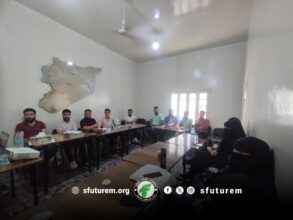The Necessity of Climate Change Awareness in Syria

Syria, like other countries in the region and the world, is increasingly suffering from the effects of climate change. Drought, changes in rainfall patterns, and rising temperatures all impact the environment, economy, and local communities. Syria is experiencing a decrease in water levels, with the Euphrates River’s level dropping sharply. This severe drought has led to the emergence of archaeological sites that were submerged under the river waters. However, these archaeological findings do not cover the severity of the consequences of river depletion and their levels dropping to almost complete dryness.
Climate change also threatens food security in Syria. The depletion of groundwater wells and the decrease in river levels have increased the risk of food insecurity, and the United Nations has warned of a hunger crisis due to drought and climate change. Additionally, climate change and the conflict in Syria have led to the destruction of agricultural land, evidenced by drought, long heatwaves, and dried-up rivers that have left their mark on Syrian agricultural lands.
Climate change poses a significant challenge for Syria. Drought, changes in rainfall patterns, and rising temperatures all impact the environment, economy, and local communities. Addressing these challenges requires joint efforts at the local, regional, and global levels.
Effects of Climate Change on Syria
According to scientific reports referenced in the footnotes at the end of the article, several potential impacts include:
- Increased temperatures, which could lead to unprecedented heatwaves.
- Drought, which began in 1998 in the Eastern Mediterranean region, could be worse than any drought the region has experienced in the past nine centuries.
- Heavy rains and floods.
- Negative impact on water resources, particularly due to disrupted rainy seasons, rising temperatures, and water stress in most water basins.
- Impact on food security, where drought, in addition to the decrease in river levels, increases the risk of food insecurity.
- Impact on agricultural lands, where climate change and the conflict in Syria contribute to their destruction.
Steps to Limit Climate Change
When I discussed climate change solutions with one of my students, she said, “The first solution is the departure of Bashar al-Assad, considering him a nightmare that changed everything in Syria.” Although this joke is a mix of painful humor and sarcastic truth, undoubtedly, it is the first step towards achieving the following steps called for by experts and specialists. Without a real political solution in Syria, it will be difficult to implement any reformative or developmental steps, not only in the climate aspect but in all aspects. Nevertheless, there is a great need to spread climate awareness and mention the steps that can limit climate change, which affects us all, especially the next generation of our children. These steps include:
- Expanding collaboration among all sectors and local communities to work together to face the challenges posed by climate changes.
- Establishing an accurate database and a clear information bank to provide necessary information to relevant parties and identify countries and regions affected by climate changes.
- Enhancing youth awareness, especially regarding climate issues, by providing educational resources about climate change and encouraging environmental activities.
- Reducing emissions, though we cannot prevent our people from refining crude oil due to the economic situation, transitioning energy systems from fossil fuels to renewable energy sources like solar or wind energy remains a solution in reducing emissions leading to climate change.
Conclusion:
It goes without saying that climate change is a global challenge that requires joint efforts at the local, regional, and global levels. Everyone has a role in reducing the impacts of climate change. Therefore, we recommend the following:
1- Detaching the climate change approach from the Syrian conflict and treating it as an existential threat to everyone. Thus, we emphasize the need to find cooperation formulas between various de facto authorities to address climate change.
2- Requesting international assistance, especially from the United Nations, to provide expertise and support in addressing demographic change.
Ibrahim Mustafa
Scientific Office
Research and Studies Department
Studies
Syrian Future Movement (SFM)
References:
- Climate Change: Why Should We Be Very Worried in Our Arab Countries? – BBC News Arabic
- Climate Change.. A Single Benefit in Syria Does Not Erase the Negative Consequences | Sky News Arabia (skynewsarabia.com)
- Climate Change Threatens with Famine Looming over 12 Million Syrians | Independent Arabia (independentarabia.com)
- Climate Change Disasters and Earthquake Deepen Wounds of Agricultural Areas in Syria (Report) – Energy (attaqa.net)
- Conflict and Climate Change in Syria Destroy Agricultural Land – Ozone (ozoneeg.net)
- What is Climate Change? | United Nations (un.org)
- 10 Ways You Can Help Fight the Climate Change Crisis | United Nations News (un.org)
- The Impact of Climate Changes on Syria and Ways to Confront it in a Workshop for the Ministry of Local Administration and Environment (pministry.gov.sy)
- Did Climate Change Affect Weather Conditions in Syria? (rozana.fm)






